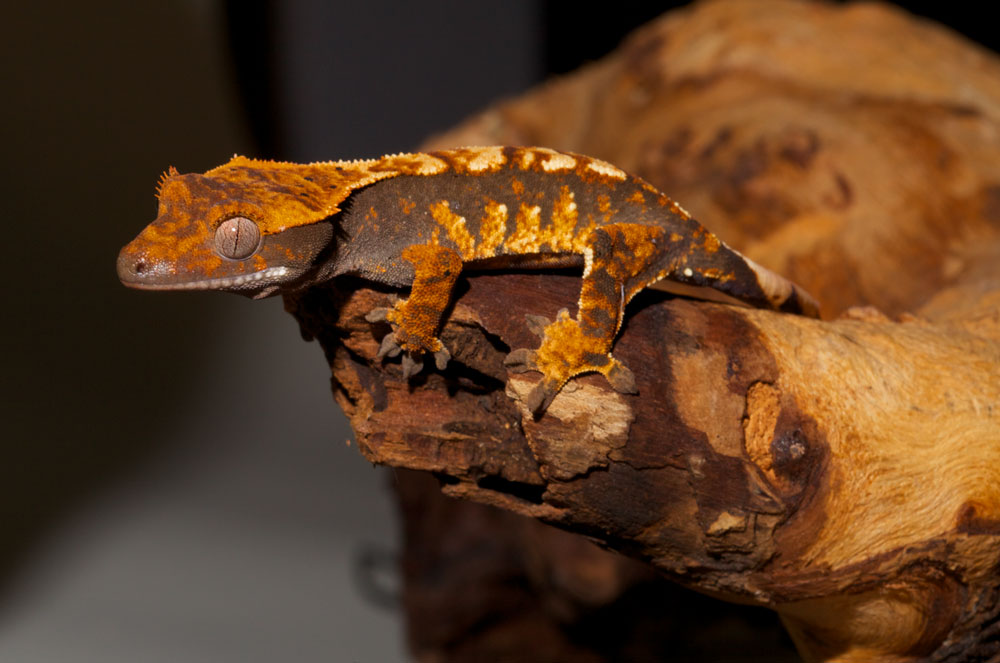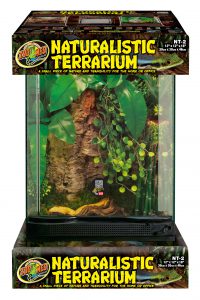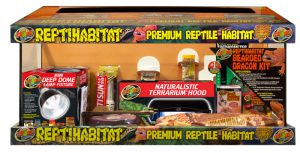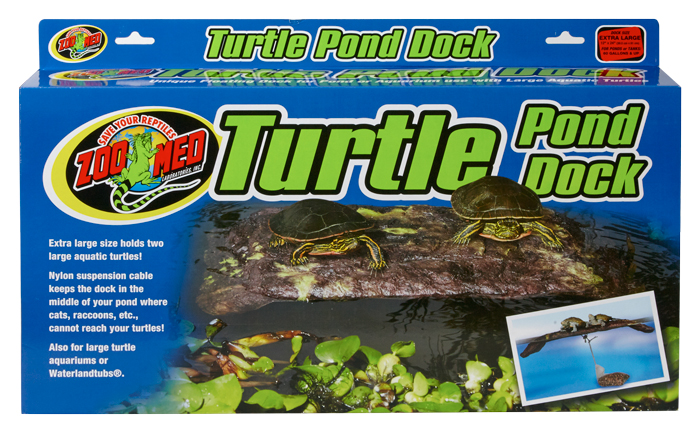There are many different ways to house reptiles. When choosing a reptile enclosure, there are several factors to take into consideration.
How big will this animal get? So, how long will this enclosure be suitable for my animal?
Where does this species spend its time? On the ground? On trees? Under the ground? In water?
How will I be providing heat and humidity for this species? Keep in mind where you will place the enclosure and that maintaining high temperatures and humidity levels in an open air habitat may be more difficult than in a solid or glass terrarium.
Are there any special considerations for this species? Does it require standing or moving water? Does it have specific needs for excellent air quality?
After determining the answers to these questions, you can choose the style and size of your enclosure. Many are available and each offers a unique set of benefits, so finding just the right animal enclosure should be a breeze! In the following modules, learn how to choose from glass terrariums, open air habitats, and alternative housing options.
ARBOREAL HOUSING
Many reptile species are arboreal, or spend their time in trees. For these species, a vertically oriented, or tall enclosure is desirable. Arboreal housing allows these species to practice natural behaviors, such as climbing and looking for food.
When preparing an arboreal habitat for pets, it is important to “furnish” it appropriately. Use of branches, live and artificial plants, vines etc… will help create an arboreal habitat and make reptiles feel at home. Be sure to research the needs of specific species as they may have unique requirements.
Old World Chameleons, for example, should have plenty of branches and vines of different sizes that they can grasp with their feet.
Crested and other New Caledonian Geckos can benefit from Cork Bark or Cork Rounds to sleep inside of.
Some Tree Frogs do best with many broad-leaf type decorations as they naturally like to sleep on the under side of foliage.
Live Ficus trees make great decor, climbing, and hiding opportunities for many different arboreal species. These trees are non-toxic and do well indoors.
Common arboreal species include: Crested Geckos, Chameleons, Day Geckos, Tree Skinks, Tree Frogs, Anoles, Iguanas, Tree Pythons, and Tree Boas.
Facts to remember:
- Arboreal, or tree dwelling animals, will benefit from a vertically oriented habitat.
- Be sure to include plenty of climbing and hiding opportunities that allow arboreal species to take advantage of vertical space.
GLASS ARBOREAL HOUSING
Glass Arboreal Housing is appropriate for many different reptile species. Glass enclosures help retain humidity and can include a water feature, such as a waterfall or “pond”. Many vertically oriented glass habitats are available and are perfect for these popular species:
Anoles, crested geckos, day geckos, tree frogs, tree pythons, tree boas, and more.
Our Naturalistic Terrariums are available in many different sizes and make great habitats for arboreal species. They come equipped with a single, swinging front door providing easy access for terrarium maintenance and animal care. The stainless steel screen top that will not corrode and accommodates any number of different lighting and heating options. The top frame of the terrarium and screen allows for top access and is appropriate for keeping feeder insects inside.
Additional Information:
- Lockable door for safety and security (combination lock not included).
- Front and top ventilation for natural air flow inside terrarium.
- 6 power cord and airline tubing exit slots.
NT-2 – 12 x 12 x 18″ terrarium is appropriate for smaller geckos, lizards and frogs.
NT-4 – 18 x 18 x 24″ terrarium is great for large geckos, breeding groups of geckos, medium sized lizards, and large Tree Frogs.
NT-5 – 18 x 18 x 36″ Skyscraper terrarium is our tallest terrarium yet and is perfect for Tree Boas, Tree Pythons, Tree Frogs, and Arboreal Lizards.
Facts to Remember:
- Glass terrariums are helpful for retaining humidity and are great for tropical, tree dwelling species.
- Waterfalls and other water features can be built in glass arboreal housing.
- A front opening door provides easy access to glass arboreal habitats.
- Adequate ventilation is an important feature in tall glass habitats to ensure air quality.
SCREEN ARBOREAL HOUSING
Open Air Arboreal Housing is an excellent choice for many species. Open air, screen habitats provide increased air flow which is very important for some species, such as many Old World Chameleons. These habitats are lighter in weight than glass terrariums and provide climbing opportunities on the walls for many species that cannot climb glass. When setting up an open air habitat, keep in mind that temperature and humidity control may be different than in a solid or glass habitat. Another benefit of these open air habitats is that they can be placed in a protected area outdoors on mild days. This is a good way to allow pets some exposure to natural, unfiltered UVB and fresh air.
ReptiBreeze®
 Open Air Aluminum Cage is great for Old World Chameleons, Juvenile Iguanas, Crested Geckos, and other species of arboreal lizards.
Open Air Aluminum Cage is great for Old World Chameleons, Juvenile Iguanas, Crested Geckos, and other species of arboreal lizards.
The ReptiBreeze is also available in the Deluxe version that features a clear acrylic door panel that allows for unobstructed terrarium viewing, an easy-to-clean, removable bottom tray that can be used to hold the substrate and excess moisture, and also features built-in, touch-activated LED lights for illuminating your pet’s habitat with three different settings.
Additional Information:
- Large front door for easy cage access and bottom door for easy substrate removal.
- Beautiful corrosion-resistant black anodized aluminum screen cage.
- All hardware included; easy to assemble using only a screwdriver.
ReptiBreeze® IguanArium®
Excellent for Green Iguanas (up to 3 feet in size), Water Dragons, large Old World Chameleons, Bearded Dragons, and many other large-sized species of lizards.
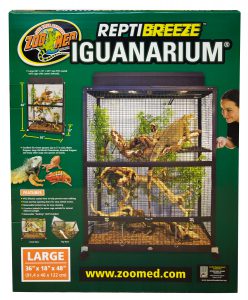
Additional Information:
- PVC (plastic) Coated wire to help prevent nose rubbing.
- Front and top opening doors for easy animal access.
- Removable bottom tray for easy cleaning.
- 4 casters (wheels) to move cage outside for natural, unfiltered sunlight.
- Removable “basking” shelf included.
Facts to Remember:
- Open air habitats help ensure excellent air quality.
- For many years, most Old World Chameleon breeders have preferred to use open-air type caging.
- Open Air caging is appropriate for outdoor use if weather permits and appropriate protection is provided.
TERRESTRIAL HOUSING
Some species use the ground more than vertical space. For these species, a habitat with a larger, longer “footprint” is appropriate. The “footprint” is the amount of space that the base of the habitat provides. Tortoises, for example, will benefit from a habitat with the largest footprint possible.
Some species, like many skinks, are “fossorial” and like to spend much of their time underground or burrowing through leaf litter. For these species, vertical space is often wasted, as they don’t naturally climb.
Many ground dwelling lizards, such as bearded dragons, swifts, and Leopard Geckos naturally climb, although they are not considered arboreal. These species should have a habitat that is horizontally oriented with a large footprint but will utilize vertical space if given branches, rocks or other cage furniture.
A great way to make use of vertical habitat space for ground dwelling species is with the use of Excavator Clay Burrowing Substrate. This product will allow you to create terrain and increase the usable space for many different species.
Facts to Remember:
- Terrestrial species spend more time on the ground than climbing on branches and benefit from a tank with a large “footprint”.
- Fossorial species will also benefit from a large tank footprint.
- Vertical space may be wasted in a very tall tank housing terrestrial species.
Here are some recommended tanks for ground dwelling species:
10 gallon –
Dimensions: 20″ x 10.5″ x 12.5″
Sliding screen top can support heat and UVB lamps while keeping feeder insects and pets inside.
Species: Leopard Gecko, Crested Gecko, Pacman Frog
20 gallon -Dimensions: 30″ x 18″ x 12.75″
Sliding screen top can support heat and UVB lamps while keeping feeder insects and pets inside.
Species: Leopard gecko (Adult, Pair, Trio), Juvenile Bearded Dragon, Cork Snake, Baby Ball Python, Kenyan Sand Boa.
40 gallon -Dimensions: 36″ x 18″ x 17″
Sliding screen top can support heat and UVB lamps while keeping feeder insects and pets inside. The screen is split into front and back pieces so that the pet can be accessed through the front screen while lamps rest on back screen.
Species: Bearded Dragon, Tortoise, Blue Tongue Skink, Fire Skink
Low Boy Dimensions: 48″ x 24″ x 10″ (50 Gallons)
Sliding screen top can support heat and UVB lamps while keeping feeder insects and pets inside. The screen is split into front and back pieces so that the pet can be accessed through the front screen while lamps rest on back screen.
Species: Small Tortoises, Skinks, and other ground-dwelling species
NT-1 12″ x 12″ x 12″
NT-3 18″ x 18″ x 18″
Add a small piece of nature and tranquility to your home or office! These Naturalistic Terrariums exclusively feature:
- Full Front glass opening door with snap closure.
- Stainless Steel screen top that will not corrode and accommodates a dome clamp lamp fixture or the optional “Light Bar”.
- Special screen top keeps feeder insects in while allowing greater UVA and UVB penetration throughout the terrarium.
Additional Information:
- Lockable door for safety and security (combination lock not included).
- Front and top ventilation for natural air flow inside terrarium.
- 6 power cord and airline tubing exit slots.
Tortoise House
Additional Information:
- The Tortoise House is easy to assemble. Its modular design allows you to remove the end panel and join two Tortoise Houses to double the amount of space for your pet.
- Made from Fir Wood.
- Dimensions of interior doorway: 8.25″ x 8″.
- Includes:
- Private weatherproof “sleeping” area.
- Lockable wire safety cover.
- Sturdy wood and metal components.
- Modular design, allowing for expansion.
Zoo Med’s Tortoise House is an excellent outdoor enclosure for Tortoises and turtles alike. Check out this step-by-step instructional video on how to put one together.
OUTDOOR HOUSING
At times, it is most appropriate to house some species outdoors. Some tortoises get too large to realistically keep indoors. Sulcata Tortoises, for example, get very large and should have access to an outdoor yard when they are grown.
Other reptiles may benefit greatly from spending some time outdoors, even if they are not permanently housed outside. Bearded Dragons, Chameleons, and Iguanas are examples of some species that can be housed outdoors when weather permits.
Considerations for outdoor housing:
Security – Keeping pets in is one of the most important functions of housing. Enclosures should be secure to prevent opening from the inside or outside. Use a Padlock or similar device to ensure that children or strangers are not opening your pet’s habitat when you are not around. Some pets are excellent diggers, so if they are housed on the natural ground, it may be necessary to bury wire or bricks to ensure that they cannot burrow out of the habitat. For some species, a solid “wall” type fence may be most efficient. Tortoises, for example, are less likely to go where they cannot see, so building a block wall can help relieve stress and prevent fence walking.

Protection from Predators – Just as important is keeping predators and unwanted people and animals out of the habitat. Even in urban areas, predators are common, and depending on the size of the pet, can include domestic cats, dogs, crows, raccoons, skunks, coyotes, rats, birds of prey, and more. Although rats and mice may not seem like much of a threat, pet reptiles should be protected from them while being housed outdoors as they may carry disease, may bite or chew on pets, or could have been exposed to toxins or poisons elsewhere. Pets should not be allowed to eat rodents or other animals that appear in their habitat or yard.
Another tiny pest to look out for is ants. These little insects may be harmless individually, but in large numbers, can cause severe irritation and even damage to pets that cannot get away from them. Placing cage legs or food dishes in a container filled with water can help prevent ants from getting to food or to your pet.
*When housing reptiles outdoors, try to protect your pets from ant colonies and other pests.
Protection from Weather and Temperature Control –
In outdoor habitats, it is much more difficult to control the temperature and humidity to strict parameters, so it is important not to house animals outdoors if the natural temperature is very far from acceptable levels for your species. For some species, daytime temperatures may reach ideal levels, while night time levels may drop too low. A heated indoor “bedroom” or house may be provided. If this method is used, it is important for keepers to ensure that pets know how to find this temperature controlled space and that they regularly use it. Often, showing the pet to its bedroom at night for a few weeks will teach it, but keepers should always check on animals, especially on very cold nights.
Even where the weather does not get extreme, some form of protection should always be provided to allow pets to hide from sun, wind, and rain.
Facts to Remember:
- Some species may do best in outdoor housing, especially as adults.
- Factors to consider when deciding on and building outdoor housing include:
- Security
- Predator protection
- Temperatures and weather protection
- Appropriate terrain (steep hills may be problematic for some species) Very rocky ground can also cause some problems. Be aware of holes and flooding!
AQUATIC HOUSING
When selecting an aquatic habitat, be sure that it is designed to hold water. Although terrariums and aquariums often look similar, tanks designed for aquatic conditions are often made with better seals and thicker glass in order to be able to hold the weight of the water. Fresh water weighs approximately 8 pounds per gallon, so 10 gallons is about 80 pounds! When in doubt, check with the manufacturer.
Most Aquatic Turtle species should have access to a dry basking area. Be sure to take this into consideration when choosing an aquatic habitat. There are a number of ways to accomplish this, including Turtle Docks, Branches, Rocks, and more. A Turtle Dock is one of the easiest ways to provide a safe basking area for turtles.
The Zoo Med Turtle Dock® and Turtle Pond Dock® are unique floating docks for aquatic turtles to bask on. A self-leveling feature automatically adjusts to all water levels. The submerged ramp allows Turtles easy access to a dry basking area for maximum exposure to heat and UVB lamps. Available in multiple sizes to easily accommodate any size aquatic Turtle.
Zoo Med makes the following enclosures that are suitable for Aquatics:
10 gallon
Dimensions: 20.25″ x 10.5″ x 12.5″
Good for: Hatchling Aquatic Turtles, Aquatic Newts, Aquatic Frogs
20 gallon
Dimensions: 30.25 x 12.5 x 12.75″
Good for: Small Juvenile Turtles, Musk Turtles, Mud Turtles, Aquatic Newts, Aquatic Frogs
40 gallon
Dimensions: 36.25 x 18.25 x 17″
Good for: Juvenile Aquatic turtles (Painted Turtles, Map Turtles, Sliders, Sideneck Turtles, Diamondback Terrapins, etc…) Mud and Musk Turtles
Dimensions: 48″ x 24″ x 10″
Good for: Hatchling and small juvenile turtles, Mud and Musk turtles,
Turtle Tub
Features:
- A built-in land/water area.
- Large land area allows natural basking and egg laying behavior.
- Lightweight and easy to clean.
- The TurtleTub® is available separately or as a complete kit.
- Made in the USA from 100% recycled materials.



